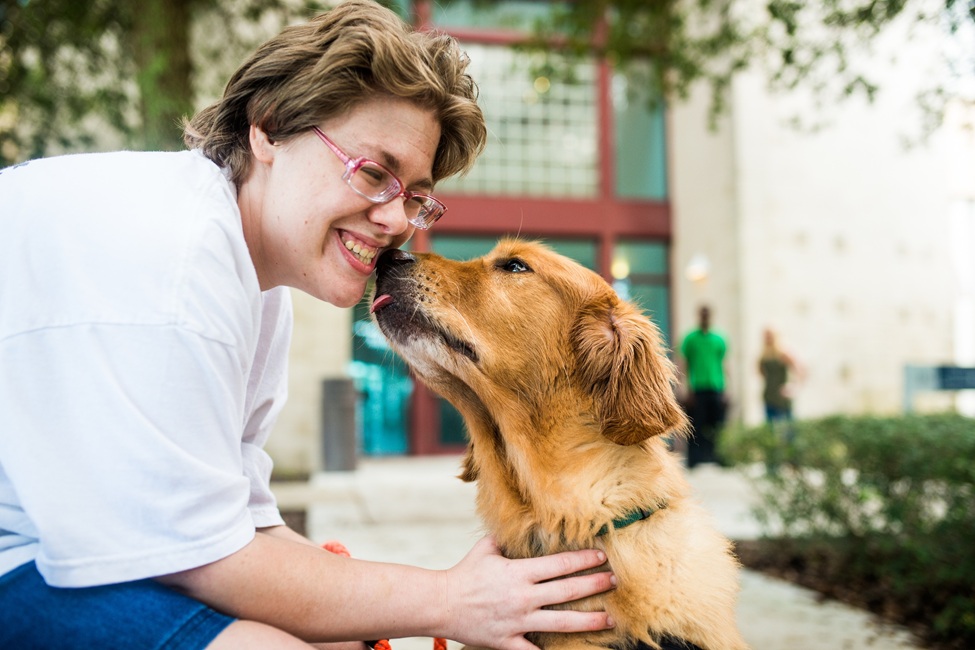Study: 'Man's Best Friend' Slows Cellular Aging in Female Veterans

The study focused on U.S. female veterans and is among the first to examine the impact of working with service dogs in this population. (Photo by Alex Dolce)
New research finds that “man’s best friend” may help slow biological aging in women. This groundbreaking study, focused on female veterans in the United States, is among the first to examine the impact of working with service dogs on this often-overlooked population. By measuring biological indicators of stress, the researchers have uncovered a key insight: the way stress is felt emotionally doesn’t always reflect how it affects the body at a cellular level.
While women have served in the U.S. military for generations, their roles have expanded dramatically since 1948. Yet despite their growing presence and unique experiences, most military studies still center on men – even as women report higher rates of PTSD.
Building on the need for focused research, Florida Atlantic University researchers, in collaboration with the University of Maryland School of Nursing, the Medical College of Georgia, and Warrior Canine Connection, Inc., conducted the study involving female veterans with post-traumatic stress disorder. But instead of receiving service dogs, these women volunteered to train them for fellow veterans in need – offering support not just to others, but potentially to themselves.
The study, supported by the National Institutes of Health’s Eunice Kennedy Shriver National Institute of Child Health & Human Development, examined whether this purposeful, mission-driven activity could reduce both biological and psychological stress, and whether previous combat exposure influenced those effects. Until now, the emotional and therapeutic benefits of such unique relationships have been largely unexamined in female veterans.
To measure biological stress, researchers looked at telomere length (a marker of cellular aging) using saliva samples, and heart rate variability (HRV), a sign of nervous system balance, using wearable monitors in participants in the service dog training program group or a comparison group that watched dog training videos. Psychological stress was assessed using validated questionnaires measuring PTSD symptoms, perceived stress, and anxiety at multiple points during the study.
Results, published in the journal Behavioral Sciences, revealed promising biological benefits associated with service dog training – particularly for veterans with combat experience – while improvements in psychological symptoms were seen across all participants, regardless of the intervention.
One of the most striking findings involved telomere length. Veterans who participated in the dog-training program showed an increase in telomere length, suggesting a slowing of cellular aging. In contrast, those in the control group exhibited a decrease in telomere length, indicating accelerated aging. Combat experience significantly influenced these results: veterans with combat exposure who trained service dogs experienced the greatest gains in telomere length, whereas those with combat exposure in the control group saw the most pronounced declines.
On the psychological front, both groups – those who trained dogs and those in the control group – reported significant reductions in PTSD symptoms, anxiety and perceived stress over the eight-week period. However, these mental health improvements were similar across groups, suggesting that simply participating in the study and receiving structured attention may have offered therapeutic value. Unlike the biological findings, psychological outcomes did not appear to be affected by combat exposure.
“Female veterans face unique reintegration challenges that are often overlooked, and traditional PTSD treatments don’t always meet their needs,” said Cheryl Krause-Parello, Ph.D., first author, associate vice president for FAU research, associate executive director, FAU I-Health, and director of C-PAWW™. “Nontraditional approaches like connecting with animals can offer meaningful support. These relationships provide emotional safety and stability, which can be especially powerful for women. But not all veterans can care for a service animal, so animal-related volunteerism may offer similar healing benefits without the burden of ownership.”
The study also suggests that the skills learned during service dog training – such as positive reinforcement and reading animal behavior – may have strengthened participants’ bonds with their own pets at home, offering additional emotional support. Unlike general volunteering, service dog training uniquely blends emotional healing with building a close relationship between veterans and their animals, providing therapeutic benefits that go beyond typical community engagement.
“This research underscores the power of service dog training as a meaningful, non-pharmacological intervention to support the health and healing of female veterans with PTSD,” said Krause-Parello. “It opens the door to more personalized approaches that nurture both the mind and body.”
Female veterans aged 32 to 72 were randomly assigned to either the service dog training program group or a comparison group that watched dog training videos. Both groups took part in one-hour sessions each week for eight weeks. Researchers measured outcomes before, during and after the program.
These findings provide early evidence that non-pharmacological interventions – such as service dog training – may help reduce the physical toll of stress and slow cellular aging in female veterans.
Study co-authors are Erika Friedmann, Ph.D., corresponding author and professor emerita, University of Maryland School of Nursing; Deborah Taber, senior research project coordinator, University of Maryland School of Nursing; Haidong Zhu, M.D., Medical College of Georgia; Alejandra Quintero, a Ph.D. neuroscience student in FAU’s Charles E. Schmidt College of Science; and Rick Yount, founder and executive director, Warrior Canine Connection, Inc.
-FAU-









